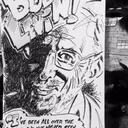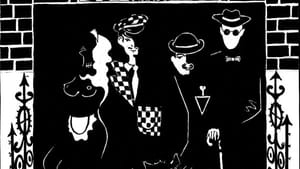Stay in the Loop
BSR publishes on a weekly schedule, with an email newsletter every Wednesday and Thursday morning. There’s no paywall, and subscribing is always free.
Max and I had agreed on books, from Blackboard Jungle through The Stranger. But then he recommended The Master and Margarita, and I could not get traction. It was the '60s, and our differing preferences in stimulants had already opened a breach that allowed me to put our opposing judgments down to something somewhere between shifting lifestyles and him being fucked brain-wise.
Max did not endure, but the Master has. It inspired cinematic adaptations (German, Yugoslavian, Russian, Hungarian, Israeli) and works for TV (Russian and Polish), the stage, ballet, orchestra, opera, and musical comedy. It supposedly influenced Mick Jagger’s composition of “Sympathy for the Devil,” and Baz Luhrmann has been pitching a film version of it for years.
So I thought, time to reconsider.
The author’s story alone compels a second look. Mikhail Bulgakov was born in 1891 in Kiev. His grandfathers had been priests, and his father was a professor of theology. Bulgakov quit med school to serve in World War I, with the white army during the Civil War, and the Ukranian Nationalists after that. He was, at various times, severely wounded, struck by typhus, addicted to morphine, and subject to mental breakdowns. His literary career, which began in 1921, was virtually over by 1929, due to Soviet censorship. Stalin denied Bulgakov permission to emigrate — but, having been enough of a fan to see one of his plays 15 times, did not have him winterized in Siberia or killed. He even allowed Bulgakov to write, but his novels went unpublished and his plays unperformed.
Bulgakov worked on The Master and Margarita from 1928 until dying from a genetically transmitted kidney disease, in 1940. It was published in 1967.
Black magic and true love
The novel has two parts. In the first, a quartet of unusual characters appear, unannounced, in Moscow. Their leader, Woland, presents himself as a stage performer of black magic. His company includes Korovyov, who is exceedingly tall, exceedingly thin, and usually sports a broken pince-nez; Behemoth, a gigantic black cat, who can walk on his hind legs and speak; and Azazello, a one-eyed, knife-wielding, fanged fellow. Over several days, they subject citizens, usually of the theatrical and literary communities, to a series of comic, grotesque undoings, including decapitation, arrest, institutionalization, and banishment. To a populace accustomed to people disappearing without explanation, these events do not startle as they otherwise might.
This action is interrupted periodically by a narrative involving Pontius Pilate and the crucifixion of Yeshua Ha-Notsri. If this is not disconcerting enough, this portion seems to be presented by different narrators, though each resumes where his predecessor left off. Amidst this confusion, an unpromising individual appears, who identifies himself as the Master.
But Margarita does not surface until Part Two. Once she does, Bulgakov alerts us that this has become a story of “everlasting love.” What had seemed a conglomerate of over-the-top, adolescent score-settlings, satisfying in a manic Terry Southern-ish way but not building to fill the heart, grip the throat, or electrify the mind, now transforms into a tale of unquenchable passion and august drama. But since reward has, so far, been absent from these pages and punishment meted out disproportionate to sin — and since the primary meter-out, the hero, if you will, on whom the lovers’ end depends, is Satan — one cannot assume their Happy Ending guaranteed.
Not just a simple satire
I suppose, when first encountering the book I expected a response to Stalinism of a familiar type, a satiric fable like Animal Farm or a focused exposé such as Darkness at Noon. But Bulgakov, who, unlike Orwell or Koestler, not only lived amidst the Terror but held little hope his work would be read in his lifetime — and, moreover, knew the doom his genes carried would make this lifetime short — had tacked in a direction for which I was not prepared. He had dealt with these challenges — these, indeed, twinned madnesses, one imposed by history and the other fate — through the full, flailing exercise of will, intelligence, and faith. He had veered left, right, north, south, up, down, punched from floor, kicked from ceiling, floated like butterfly, stung, you know, like bee. The result, as noted in Ellendea Proffer’s illuminating afterward to the Burgin-O’Connor translation, is that readers, not knowing how to categorize the book, had difficulty finding footing and taking a stance in relation to it.
Bulgakov poured into The Master and Margarita gleanings from Gogol and Goethe, Schubert and Schiller, Dumas and Dostoevsky, Verdi, Pushkin, and Descartes. He infused it with poetry and pop, history and myth, folklore and current events, autobiography and dream, Manichean thought and the gospel, traditional and apocalyptic. There are parks and a department store and a witches' ball. Light contrasts with dark; and the moon — red and green, bright and warm — struggles with the sun.
One novel occurs within another, and the narrator of the latter, with presumed responsibility for both, confesses to reporting matters he cannot explain and uncertainty whether some events he has described took place. These doubts do not dissuade him pronouncing on ethics and morality. Courage is a virtue to be treasured, he instructs, and compassion may move the Devil to bestow favors, providing you don’t ask.
By the climactic chapter, the slapstick has vanished; the laughter is over; the burlesque has ended. Now night unmasks illusion. Now silence speaks. Now Bulgakov delivers the conclusion he has drawn from the rugged paths he walked. He promises us that anyone who has greatly suffered “without regret. . .forsakes the mists of the earth, its swamps and rivers, and sinks into the arms of death with a light heart, knowing that death alone. . .”
That death alone. . .what? The final ellipsis is Bulgakov’s. Perhaps he still doubted. Or perhaps not. For later in the chapter, Woland proclaims, “Everything will be made right, that is what the world is built on.”
Then again, the Devil only knows if that is true.
Max was right. The book’s a trip.
What, When, Where
The Master and Margarita, a novel by Mikhail Bulgakov. Written between 1928 and 1940, first published in book form in 1967, first uncensored version in 1973.
Sign up for our newsletter
All of the week's new articles, all in one place. Sign up for the free weekly BSR newsletters, and don't miss a conversation.

 Bob Levin
Bob Levin
